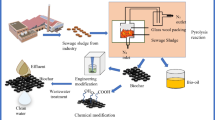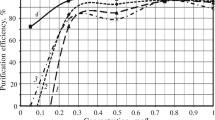Abstract
The potential for improving the efficiency of wastewater biological treatment by using carbonate slime (heat power engineering waste) as a secondary material resource is illustrated by the case of Kazan Synthetic Rubber Works. The details of interaction between carbonate slime and activated-sludge microorganisms with inorganic components of plant wastewater are considered. The authors came to the conclusion that adsorption material should be used and developed a process flow chart for wastewater biosorption treatment.
Similar content being viewed by others
References
Voronov, Yu.V. and Yakovlev, S.V., Vodootvedenie i ochistka stochnykh vod (Wastewater Disposal and Treatment), Moscow: Assots. stroit. vuzov, 2006.
Vremennaya metodika rascheta predotvrashchennogo ekologicheskogo ushcherba (Provisional Guidelines for Calculating Prevented Ecological Damage), Danilov-Danil’yan, V.I., Ed., Moscow: Goskomekologiya Rossii, 1999.
GOST (State Standard) 2093-82: Solid Fuel. Sieve Method to Determine Particle Size Distribution, 2001.
GOST (State Standard) 1625-89: Technical formalin. Technical Specifications, 1989.
GOST (State Standard) 29304-92: Technical ammonium nitrate. Method to determine ammonium nitrogen (titrimetric) after distillation, 2004.
GOST (State Standard) R 50595-93: Surfactants. Method to determine biodegradability in water, 1994.
Zosin, A.P., Priimak, T.I., Masloboev, V.A., Sulimenko, L.P., and Mingaleva, T.A., Variations in wastewater composition in the water use system of Kovdorskii Mining-and-Processing Integrated Works, Water Resour., 2011, vol. 38, no. 1, pp. 113–123.
Inzhenerno-ekologicheskii spravochnik (Engineering- Ecology Reference Book), Timonin, A.S., Ed., Kaluga: Izd. N. Bochkarevoi, 2003, vol. 3.
Medvedev, V.T., Inzhenernaya ekologiya (Engineering Ecology), Moscow: Gardariki, 2002.
Nikolaeva, L.A. and Iskhakova, R.Ya., Wastewater biosorption treatment at industrial plants, Teploenergetika, 2012, no. 3, pp. 78–80.
PND F 14.1:2.110-97 Kolichestvennyi khimicheskii analiz vod. Metodika vypolnenii izmerenii soderzhanii vzveshennykh veshchestv i obshchego soderzhaniya primesei v probakh prirodnykh i ochishchennykh stochnykh vod gravimetricheskim metodom (Quantitative Chemical Analysis of Water. Methods of Measuring Suspended Matter Concentration and Total Solute Concentrations in Samples of Natural Water and Treated Wastewater by Gravimetry), Moscow, 1997.
PND F T14.1:2:3:4.12-06 T 16.1:2:2.3:3.9-06 Toksikologicheskie metody analiza. Metodika opredeleniya ostroi toksichnosti pit’evykh, presnykh prirodnykh i stochnykh vod, vodnykh vytyazhek iz pochv, osadkov stochnykh vod i otkhodov po smertnosti dafnii (Daphnia magna Straus) (Toxicological Methods of Analysis. Methods to Determine the Acute Toxicity of Drinking, Fresh Natural Waters and Wastewaters, Aqueous Extracts from Soils, Wastewater Residue, and Wastes by the Death Rate of Daphnia (Daphnia magna Straus), Moscow: Fed. Tsentr Anal. Ots., 2011.
Potashnikov, Yu.M., Utilizatsiya otkhodov proizvodstva i potrebleniya (Utilization of Production and Consumption Wastes), Tver: Tver. Gos. Techn. Univ., 2004.
Rukovodstvo po opredeleniyu metodom biotestirovaniya toksichnosti vod, donnykh otlozhenii, zagryaznyayushchikh veshchestv i burovykh rastvorov (Guide for Determining the Toxicity of Water, Bottom Sediments, Pollutants, and Drill Muds), Moscow: REFIA, NIAPriroda, 2001.
Sirotkin, A.S., Ponkratova, S.A., and Shulaev, M.V., Sovremennye tekhnologicheskie kontseptsii aerobnoi ochistki stochnykh vod (Modern Technological Concepts of Wastewater Aerobic Treatment), Kazan: Kaz. Gos. Tekh. Univ., 2002.
Shtamm, E.V., Skurlatov, Yu.I., Kozlova, N.B., Zaitseva, N.I., and Aleksandrova, E.V., Bioassaying in the assessment of wastewater treatment process efficiency, Water Resour., 2011, vol. 38, no. 2, pp. 237–243.
Yakovlev, S.V., Skirdov, I.V., and Shvetsov, V.N., Biologicheskaya ochistka proizvodstvennykh stochnykh vod. Protsessy, apparaty i sooruzheniya (Biological Treatment of Industrial Wastewaters: Processes, Apparatuses, and Structures), Moscow: Stroiizdat, 1985.
Author information
Authors and Affiliations
Corresponding author
Additional information
Original Russian Text © L.A. Nikolaeva, A.G. Laptev, R.Ya. Iskhakova, 2018, published in Vodnye Resursy, 2018, Vol. 45, No. 2.
Rights and permissions
About this article
Cite this article
Nikolaeva, L.A., Laptev, A.G. & Iskhakova, R.Y. Improving the Efficiency of Wastewater Biological Treatment at Chemical Plants. Water Resour 45, 231–237 (2018). https://doi.org/10.1134/S0097807818020136
Received:
Accepted:
Published:
Issue Date:
DOI: https://doi.org/10.1134/S0097807818020136




